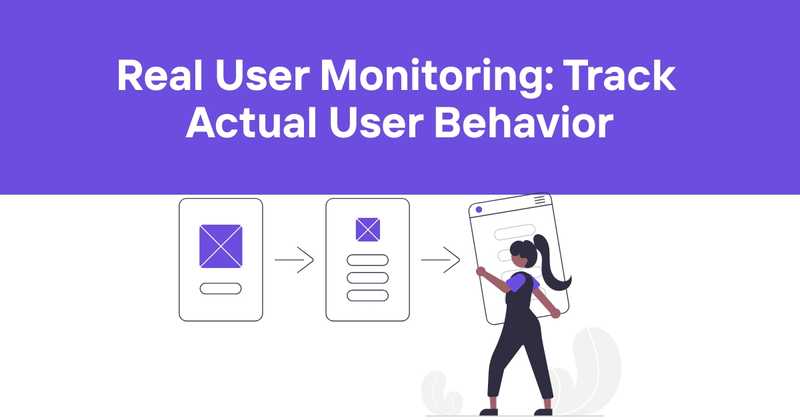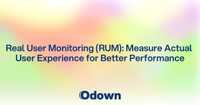Real User Monitoring: Track Actual User Behavior
Real user monitoring (RUM) has become an essential tool for organizations seeking to optimize their digital presence and provide exceptional user experiences. This powerful technique allows businesses to gain valuable insights into how actual users interact with their websites and applications in real-time. By capturing and analyzing data from real user sessions, RUM enables organizations to identify performance issues, understand user behavior, and make data-driven decisions to improve their digital offerings.
Table of Contents
- What is Real User Monitoring?
- How Real User Monitoring Works
- Key Metrics in Real User Monitoring
- Benefits of Real User Monitoring
- Real User Monitoring vs. Synthetic Monitoring
- Challenges of Real User Monitoring
- Best Practices for Implementing Real User Monitoring
- Real User Monitoring Tools
- Future Trends in Real User Monitoring
- Conclusion
What is Real User Monitoring?
Real user monitoring is a performance monitoring technique that captures and analyzes data from actual users interacting with a website or application. Unlike synthetic monitoring, which simulates user behavior, RUM provides insights into genuine user experiences, including page load times, user journeys, and potential issues that may arise during real-world usage.
RUM tools typically work by injecting a small JavaScript snippet into web pages, which then collects data on various performance metrics and user interactions. This data is sent back to a central server for analysis, allowing organizations to gain a comprehensive understanding of their digital performance from the end-user perspective.
How Real User Monitoring Works
The process of real user monitoring can be broken down into several key steps:
-
Data Collection: A JavaScript snippet is added to the website or application, which collects data on various performance metrics and user interactions.
-
Data Transmission: The collected data is sent back to a central server, usually in real-time or near real-time.
-
Data Processing: The raw data is processed and analyzed to extract meaningful insights and identify patterns or anomalies.
-
Visualization and Reporting: The processed data is presented in dashboards, reports, and alerts, making it easy for teams to understand and act on the information.
-
Continuous Monitoring: The process continues indefinitely, allowing for ongoing performance tracking and improvement.
One of the strengths of RUM is its ability to capture data across a wide range of real-world scenarios, including different devices, browsers, network conditions, and geographic locations. This provides a more accurate representation of the user experience than synthetic monitoring alone.
Key Metrics in Real User Monitoring
Real user monitoring tools track a variety of metrics to provide a comprehensive view of user experience and application performance. Some of the most important metrics include:
1. Page Load Time
Page load time measures how long it takes for a web page to fully load in a user's browser. This metric is crucial for user experience, as slow-loading pages can lead to frustration and abandonment. RUM tools break down page load time into various components, such as:
- Time to First Byte (TTFB)
- DOM Content Loaded
- Time to Interactive (TTI)
2. User Satisfaction Score (Apdex)
The Application Performance Index (Apdex) is a standardized method for measuring user satisfaction with application performance. It categorizes user experiences into three levels:
- Satisfied: Response time is acceptable to the user
- Tolerating: Response time is longer but still tolerable
- Frustrated: Response time is unacceptable
The Apdex score ranges from 0 to 1, with higher scores indicating better user satisfaction.
3. Error Rate
Error rate measures the percentage of requests or page loads that result in errors. This metric helps identify issues that may be impacting user experience or preventing users from completing desired actions.
4. Conversion Rate
For e-commerce sites and applications with specific user goals, conversion rate is a critical metric. RUM tools can track how performance and user experience metrics correlate with conversion rates, providing valuable insights for optimization.
5. User Journey and Behavior
RUM tools can track user paths through a website or application, showing how users navigate between pages and interact with various elements. This information can be used to optimize user flows and identify areas for improvement.
6. Core Web Vitals
Google's Core Web Vitals are a set of specific factors that Google considers important in a webpage's overall user experience. These include:
- Largest Contentful Paint (LCP): Measures loading performance
- First Input Delay (FID): Measures interactivity
- Cumulative Layout Shift (CLS): Measures visual stability
RUM tools often include these metrics as they are becoming increasingly important for search engine optimization (SEO) and overall user experience.
Benefits of Real User Monitoring
Implementing real user monitoring can provide numerous benefits for organizations:
-
Improved User Experience: By identifying and addressing performance issues, organizations can enhance the overall user experience, leading to increased user satisfaction and loyalty.
-
Increased Conversion Rates: Faster-loading pages and smoother user experiences often translate to higher conversion rates for e-commerce sites and other goal-oriented applications.
-
Proactive Issue Resolution: RUM allows teams to identify and address issues before they significantly impact users, reducing support tickets and improving overall service quality.
-
Data-Driven Decision Making: With access to real user data, organizations can make informed decisions about performance optimizations, feature development, and resource allocation.
-
Competitive Advantage: Understanding and optimizing the user experience can give organizations an edge over competitors who may not be leveraging RUM data.
-
Cost Savings: By identifying and addressing performance bottlenecks, organizations can optimize their infrastructure and reduce unnecessary costs.
-
Improved SEO: As search engines increasingly factor user experience into their ranking algorithms, the insights provided by RUM can help improve search engine rankings.
Real User Monitoring vs. Synthetic Monitoring
While real user monitoring and synthetic monitoring are both valuable tools for understanding application performance, they serve different purposes and have distinct advantages:
Real User Monitoring
- Captures actual user experiences
- Provides insights into real-world usage patterns
- Identifies issues that may only occur under specific conditions
- Offers large-scale data collection
Synthetic Monitoring
- Allows for consistent, repeatable tests
- Can monitor performance before a site or application goes live
- Enables testing of specific user flows or transactions
- Provides a controlled environment for testing
Many organizations find that a combination of both RUM and synthetic monitoring provides the most comprehensive approach to performance monitoring and optimization.
Challenges of Real User Monitoring
While RUM offers many benefits, it also comes with some challenges:
-
Data Privacy Concerns: Collecting data on user behavior can raise privacy concerns, requiring careful consideration of data collection practices and compliance with regulations like GDPR.
-
Large Data Volumes: RUM can generate massive amounts of data, which can be challenging to store, process, and analyze effectively.
-
Complex Implementation: Implementing RUM across a large, complex application can be challenging, especially when dealing with single-page applications or mobile apps.
-
Interpretation of Data: With so much data available, it can be challenging to extract meaningful insights and prioritize actions based on RUM data.
-
Performance Impact: If not implemented carefully, the JavaScript used for RUM can itself impact page performance.
-
Limited Control: Unlike synthetic monitoring, organizations have limited control over the conditions under which RUM data is collected, which can make it harder to isolate specific issues.
Best Practices for Implementing Real User Monitoring
To maximize the benefits of real user monitoring, consider the following best practices:
-
Set Clear Goals: Define what you want to achieve with RUM before implementation. This will guide your choice of metrics and how you use the data.
-
Choose the Right Tool: Select a RUM tool that aligns with your specific needs, considering factors such as ease of implementation, data analysis capabilities, and integration with other tools.
-
Implement Gradually: Start with a small portion of your user base or a subset of pages, then gradually expand as you become more comfortable with the tool and process.
-
Combine with Synthetic Monitoring: Use both RUM and synthetic monitoring for a more comprehensive view of performance.
-
Focus on Key Metrics: While RUM tools can provide a wealth of data, focus on the metrics that are most relevant to your goals and user experience.
-
Regularly Review and Act on Data: Set up a process for regularly reviewing RUM data and taking action based on the insights gained.
-
Involve Multiple Teams: Share RUM data with various teams, including development, operations, and business stakeholders, to drive collaborative improvement efforts.
-
Consider Privacy: Ensure that your RUM implementation complies with relevant privacy regulations and respects user privacy.
-
Optimize for Mobile: With increasing mobile usage, ensure your RUM strategy includes a strong focus on mobile performance.
-
Correlate with Business Metrics: Try to correlate RUM data with business metrics like conversion rates or revenue to demonstrate the value of performance improvements.
Real User Monitoring Tools
There are numerous RUM tools available in the market, each with its own strengths and features. Some popular options include:
-
Google Analytics: While primarily known for web analytics, Google Analytics also offers some basic RUM capabilities.
-
New Relic Browser: Part of the New Relic observability platform, offering detailed RUM insights.
-
Dynatrace Real User Monitoring: Provides AI-powered insights and automatic problem detection.
-
Cloudflare Browser Insights: Offers RUM capabilities integrated with Cloudflare's CDN and security services.
-
Akamai mPulse: Focuses on correlating performance data with business metrics.
-
AppDynamics Browser Real User Monitoring: Part of Cisco's AppDynamics APM suite, offering end-to-end performance monitoring.
When choosing a RUM tool, consider factors such as ease of implementation, depth of analytics, integration with other tools, and cost.
Future Trends in Real User Monitoring
As technology continues to evolve, so too does the field of real user monitoring. Some emerging trends to watch include:
-
AI and Machine Learning: Increasing use of AI and ML to analyze RUM data, predict issues, and provide automated recommendations for optimization.
-
Edge Computing: Leveraging edge computing to process RUM data closer to the user, reducing latency and improving real-time insights.
-
Integration with DevOps: Tighter integration of RUM tools with DevOps processes, enabling faster feedback loops and more agile performance optimization.
-
Focus on User Journey: Moving beyond individual page metrics to provide insights into the entire user journey across multiple touchpoints.
-
Increased Privacy Features: Development of more sophisticated privacy-preserving techniques for collecting and analyzing user data.
-
Extended Reality (XR) Monitoring: As AR and VR applications become more common, RUM tools will need to adapt to monitor these new types of user experiences.
-
IoT Integration: Expanding RUM capabilities to monitor user interactions with IoT devices and applications.
Conclusion
Real user monitoring has become an indispensable tool for organizations looking to optimize their digital experiences and stay competitive in an increasingly online world. By providing insights into actual user experiences, RUM enables businesses to make data-driven decisions, improve performance, and ultimately deliver better experiences to their users.
As the digital landscape continues to evolve, the importance of RUM is only likely to grow. Organizations that effectively leverage RUM data will be better positioned to meet user expectations, drive conversions, and achieve their business goals.
For those looking to implement or improve their website monitoring strategy, tools like Odown can be invaluable. Odown offers comprehensive website and API monitoring capabilities, including uptime monitoring, SSL certificate monitoring, and public status pages. By combining these features with real user monitoring insights, organizations can ensure they're providing the best possible digital experience for their users while maintaining the security and reliability of their online presence.



